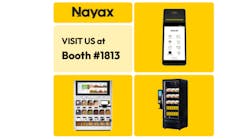In spring 2009, a NAMA Technology Leadership Committee under the direction of the NAMA Board of Directors, formed a specialized technology task force charged with developing a set of industry standards that guide data sharing among competing technology systems. This task force became known as the Vending Data Interchange (VDI) Task Force and it determined that any standards it published had to ensure vending operators of three things: reliability, continuity and longevity.
Reliability relating to how each participating technology provider would be able to receive identical machine-level data files. Continuity in terms of data retrieval and distribution throughout a vending and/or micro market operator’s network. Longevity with respect to providing assurances that interfaces between installed applications from diverse suppliers would be supported going forward.
Long-time VDI Chair Chris Lilly, vice president of IT for Compass Group explains it thus, “The purpose of the VDI Task Force is to create standards that make it easier for operators to adopt new technologies by helping to address some of the challenges related to system integration.”
Beyond the acronym, the VDI Task Force was created to shape the future of vending technology by ensuring that an operator can put into use diverse vending technology solutions and still take advantage of the operational data in existing applications regardless of the manufacturer or supplier.
VDI focus
The VDI Task Force’s initial formation put forth this objective: “Vending operators desire technology capable of reliably passing information from one application service provider to another so that multiple application service providers can contribute to a single networked solution.” This statement captures the essence of NAMA VDI standards. The purpose of NAMA VDI standards is to establish transparent, non-proprietary interfaces that enable transportation of data among the main components of vending and/or micro market system (e.g. telemetry devices, cashless payments, inventory management, warehouse operations, back office system software). From a technical perspective, the non-proprietary nature of VDI standards renders each an open standard. The essence of VDI standards is to enable data movement through a messaging technique that ensures data integrity, regardless of whether it was pulled or pushed to one or more server(s). In other words, these standards render vending technology capable of linking together diverse software solutions, from different vending technology providers and/or micro market suppliers, into unified applications. It is hoped that this synergy may well represent a tipping point in the accelerated adoption of technologies as industry operators have alternatives to single supplier-dependence.
VDI standards rely on messaging standards to satisfy data interchange needs and are not concerned with the entity transmitting or receiving such messages. For example, a messaging standard governing the transmission of machine-level DEX data may originate from the vending machine, an advanced telemetry device, or the file server of another company. VDI standards mandate that the message format conform to the technical specifications of the standard, regardless of the entity creating the message. Additionally, the VDI Task Force seeks to develop standards that are reasonable and cost effective; support transportability; are forward looking; and are readily adoptable by technology suppliers.
A challenging endeavor
The composition of the VDI Task Force was initially, and remains, highly unusual in that it brought most of the industry’s major vending technology providers to a common space and asked that they work together to produce open standards for data sharing among competing technology suppliers. Over the past six years, the task force has published two well-vetted and well-tested industry standards. These standards contain technical specifications that: a) bundle vending machine-level data for easy distribution throughout a vending operator’s technology network, and/or b) aggregate vending and micro market data within a unified network. A key characteristic of each VDI standard is that it is implementable without vending operator intervention.
In order to effectively assemble a large group of competing technology suppliers, all task force members are required to sign a VDI Participant Agreement (PA) that enables the free exchange of ideas without consideration of attribution or ownership. The form must be signed by the individual participant as well as a corporate officer of the firm they represent. The PA document helped shape VDI meetings by defining key components required for industry standards. For example, member contributions are explained in the PA as “any tangible or intangible information (including literary drafts, literary final versions, pictorial works, graphical works, notes, memoranda, work sheets, charts, data, formulas, designs, drawings, programs, documents, specifications, processes, and flowcharts) created specifically for or provided to the task force for its use in developing and publishing a standard.” Such transparency allowed VDI meetings to operate as an open, free-flowing exchange of ideas without consideration of source.
The Task Force, therefore, provides a safe harbor for the sharing of technical information without retribution. As a result, each task force member grants NAMA a non-exclusive, perpetual, world-wide, royalty free, license to develop and publish industry technology standards. The PA ensures that no task force activity grants a NAMA member, an individual, or another party the right to use a contribution to the committee for any purpose other than to practice the standard.
Published Standards
The two published VDI Task Force Standards are 1) Server to Server (S2S) DEX and 2) Vending to Micro Market (VMS-MMS) standard. VDI compliant standards can be found online at the vending.org website under the technology tab.
VDI Benefits
NAMA VDI standards afford several direct benefits to operators, especially those embarking on technology decisions. When purchasing vending technology from a company adhering to the NAMA VDI standards, the buyer is assured investment in industry technology is compatible with VDI compliant industry suppliers. VDI standards are open standards.
Summary
There are primarily two types of machine-level data that can be monitored in the vending industry: transactional data and operational data. Transactional data includes facts related to purchase activation, product selection, pricing, sales and payments while operational data involves error messages, conditional alerts and functionality reporting. Simply stated, vending operators seek technology applications capable of reliably passing these data from one application or system to another, thereby enabling multiple applications to contribute to a comprehensive, networked solution. It is for this reason that there has been an emerging interest in developing technology standards that enable data sharing among disparate component parts. Creating a platform for such integration has been the work of the NAMA Vending Data Interchange (VDI) Task Force.
The goal of NAMA VDI standards is to ensure that a vending operator can confidently implement multiple, diverse vending technology solutions and utilize the operational data in existing application software (regardless of supplier).
NAMA VDI specifications are designed to be extensible, uniform and stable as well as manufacturer and device agnostic. In other words, NAMA VDI standards are open technology standards.
NAMA VDI S2S DEX relies on messaging standards to satisfy data interchange needs and is not concerned with the entity transmitting or receiving such messages.
The NAMA VMS-MMS standard delineates each system’s role in creating, maintaining and managing specific data sets. NAMA VDI ensures that operators can feel confident in technology investment, choice of suppliers and be assured that hardware and software will work together now and in the future. There has never been a better time to invest in VMS and/or MMS technology.
About the Author
Michael Kasavana, Ph.D., is the Emeritus NAMA Endowed Professor in Hospitality Business, The School of Hospitality Business at Michigan State University having retired from MSU. He can be reached at: [email protected]

Michael Kasavana | Ph.D.
Michael L. Kasavana, Ph.D., is the Emeritus NAMA Endowed Professor in Hospitality Business, The School of Hospitality Business at Michigan State University having retired from MSU after nearly four decades of teaching and research. Kasavana holds CHTP (Certified Hospitality Technology Professional) and NCE5 (NAMA Certified Executive) certifications. He remains an active researcher and consultant, focusing on current and near future developments in hospitality-related technologies including: electronic commerce, self-service applications, property management systems, and transaction processing technology. He has also created a series of instructional materials, industry manuals, and software products.
Dr. Kasavana is engaged in innovative and creative solutions for both attended and unattended points of sale for various aspects of the hospitality industry including online and offline, cash and cashless, contact and contactless, physical and virtual data exchange, location-based services, and interchange and merchant fee based digital media. He has conducted extensive research on the impact of technology on hospitality industry productivity, profitability, and competitive advantage and is credited with coining the phrases “V-Commerce”, “V-Engineering”, “Menu Engineering”, and “Auto-Coursing.”
Dr. Kasavana was named the NAMA Industry Person of the Year in 2011 and is a recipient of the MSU Distinguished Faculty Award. In addition, he was inducted into the HFTP International Technology Hall of Fame and was presented the Distinguished Lifetime Achievements Award from FS/TEC for foodservice technology innovation. He has authored, or co-authored, several books, including the industry best-selling texts Managing Front Office Operations (9th edition) and Managing Technology in the Hospitality Industry (7th edition) and has published more than two hundred articles in academic and trade journals.
Dr. Kasavana earned BS (Hotel, Restaurant and Travel Administration), MBA (Finance), and Ph.D. (Management Information Systems) degrees from the University of Massachusetts - Amherst.





